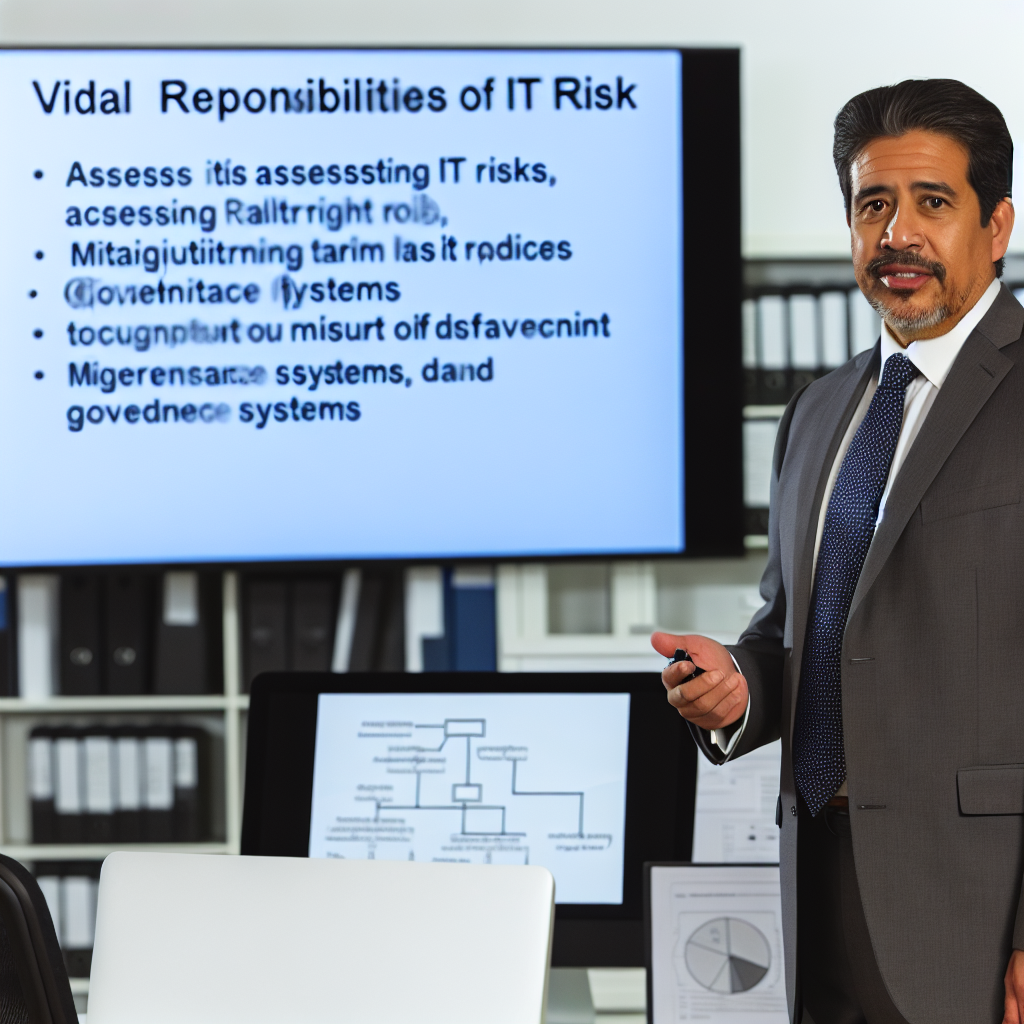Introduction:
An IT Risk Manager is responsible for identifying, assessing, and mitigating risks related to IT systems and infrastructure in an organization.
They play a crucial role in ensuring the security and integrity of data and technology assets.
Key Responsibilities:
- IT Risk Managers conduct thorough assessments to identify potential risks and vulnerabilities within the organization’s IT systems.
- They develop and implement strategies to minimize or eliminate risks through security measures, policies, and procedures.
- IT Risk Managers ensure that the organization complies with relevant laws, regulations, and industry standards related to IT security.
- They create and execute plans for responding to security incidents, including data breaches or cyber attacks.
- IT Risk Managers continuously monitor the organization’s IT systems for potential threats and vulnerabilities.
- They educate employees on best practices for IT security and data protection to prevent breaches.
- IT Risk Managers develop strategies to ensure the organization can operate smoothly in the event of a security incident.
Importance in Organizations:
IT Risk Managers are essential in safeguarding sensitive information, maintaining business continuity, and protecting the organization’s reputation.
By identifying and managing risks proactively, they help prevent financial losses, legal consequences, and damage to the organization’s brand.
Assessing risks:
– Identifying potential risks related to IT systems and infrastructure
– Analyzing the impact of these risks on the organization
When it comes to the key responsibilities of an IT Risk Manager, one of the most crucial tasks is assessing risks.
This involves pinpointing potential threats and vulnerabilities that could affect the organization’s IT systems and infrastructure.
It is essential to conduct a thorough analysis to understand the severity of these risks and their potential impact on the organization’s operations.
Identifying potential risks:
One of the primary responsibilities of an IT Risk Manager is to identify all potential risks related to the organization’s IT systems and infrastructure.
This involves examining various aspects of the IT environment, such as network security, data protection, and system vulnerabilities, to identify areas of weakness that could be exploited by cyber threats.
The IT Risk Manager must work closely with IT teams and other stakeholders to gather information about existing systems and processes, as well as any upcoming changes or projects that could introduce new risks.
By conducting comprehensive risk assessments, the IT Risk Manager can proactively identify and prioritize potential threats, allowing the organization to take appropriate measures to mitigate these risks effectively.
Analyzing the impact of these risks on the organization:
Once potential risks have been identified, the IT Risk Manager must analyze the potential impact of these risks on the organization.
This involves assessing the likelihood of each risk occurring and the extent of damage it could cause to the organization’s operations, financial stability, reputation, and compliance status.
By conducting a thorough risk analysis, the IT Risk Manager can provide valuable insights to the organization’s leadership team, enabling them to make informed decisions about risk mitigation strategies and resource allocation.
This information is essential for developing effective risk management plans that address the organization’s most critical vulnerabilities and ensure business continuity in the face of potential threats.
The ability to assess risks effectively is a fundamental skill for an IT Risk Manager.
By identifying potential risks and analyzing their impact on the organization, the IT Risk Manager plays a vital role in safeguarding the organization’s IT systems and infrastructure against cyber threats and other security risks.
Developing risk management strategies:
Transform Your Career Today
Unlock a personalized career strategy that drives real results. Get tailored advice and a roadmap designed just for you.
Start Now– Creating policies and procedures to mitigate risks
– Implementing risk management frameworks to prevent security breaches
One of the key responsibilities of an IT Risk Manager is developing risk management strategies to ensure the security and integrity of the organization’s IT systems and data.
This involves creating policies and procedures that help identify potential risks and vulnerabilities, as well as implementing frameworks to mitigate these risks effectively.
Creating policies and procedures to mitigate risks
One of the fundamental aspects of risk management is establishing clear policies and procedures to address potential threats to the organization’s IT infrastructure.
This involves conducting risk assessments to identify vulnerabilities and develop strategies to mitigate these risks effectively.
The IT Risk Manager is responsible for working with key stakeholders across the organization to develop and implement policies that promote a culture of security and compliance.
This includes creating guidelines on how to handle sensitive information, establishing access controls, and ensuring regular security audits are conducted to identify any gaps in the system.
By creating policies and procedures that are tailored to the organization’s specific needs, the IT Risk Manager can help reduce the likelihood of security incidents and minimize the impact of potential breaches.
This proactive approach to risk management is essential in today’s digital landscape, where cyber threats are constantly evolving and becoming more sophisticated.
Implementing risk management frameworks to prevent security breaches
In addition to creating policies and procedures, the IT Risk Manager is also responsible for implementing risk management frameworks that help prevent security breaches and ensure the organization’s IT systems are secure.
This involves adopting industry best practices and standards to assess and address potential risks effectively.
The IT Risk Manager must have a thorough understanding of various risk management frameworks, such as ISO 27001, NIST, and COBIT, to help establish a comprehensive risk management program.
By leveraging these frameworks, the IT Risk Manager can identify vulnerabilities, prioritize risks, and develop strategies to mitigate these risks effectively.
Furthermore, the IT Risk Manager plays a crucial role in monitoring and evaluating the effectiveness of these risk management frameworks to ensure they are aligned with the organization’s business objectives and regulatory requirements.
By regularly assessing the organization’s risk posture, the IT Risk Manager can proactively identify and address potential vulnerabilities before they escalate into major security incidents.
Importance of Risk Management Strategies
Developing risk management strategies is a critical responsibility of an IT Risk Manager.
By creating policies and procedures to mitigate risks and implementing risk management frameworks to prevent security breaches, the IT Risk Manager can help safeguard the organization’s IT systems and data from potential threats effectively.
Learn More: Best Practices for SOC Analysts: Tips and Tricks
Showcase Your Business Today
Reach thousands of readers actively exploring professional services. Publish your business profile and grow your audience now.
Publish NowCollaborating with IT teams:
Collaboration with IT teams is a fundamental aspect of an IT Risk Manager’s role.
By working closely with IT professionals, the risk manager can effectively identify, assess, and mitigate potential risks within the organization’s IT infrastructure.
One of the key responsibilities of the IT risk manager is to collaborate with IT teams to address vulnerabilities.
This involves working together to identify weak points in the system, whether they are related to hardware, software, or human error.
By engaging with IT professionals, the risk manager can gain valuable insights into potential risks and develop strategies to mitigate them effectively.
In addition to addressing vulnerabilities, the IT risk manager also provides guidance on risk management best practices to IT teams.
This includes educating them on the importance of risk management, as well as implementing strategies and processes to minimize risks effectively.
By sharing best practices with IT professionals, the risk manager can ensure that the organization is equipped to handle potential threats and protect sensitive data.
Overall, collaborating with IT teams is essential for an IT risk manager to fulfill their responsibilities effectively.
By working closely with IT professionals and providing guidance on risk management best practices, the risk manager can help mitigate risks, strengthen security measures, and safeguard the organization’s IT infrastructure from potential threats.
- Working closely with IT professionals to address vulnerabilities
- Providing guidance on risk management best practices
Uncover the Details: Effective Stakeholder Management for Release Managers
Monitoring and Reporting:
- Regularly monitoring IT systems for signs of potential risks
- Generating reports on risk assessment findings and recommendations
Monitoring and reporting are crucial aspects of an IT risk manager’s role.
By staying vigilant and analyzing data, IT risk managers can proactively identify potential risks before they escalate into major issues.
This section will delve into the key responsibilities related to monitoring and reporting in more detail.
Regular Monitoring of IT Systems:
One of the primary responsibilities of an IT risk manager is to continuously monitor IT systems for any signs of vulnerabilities or potential risks.
This involves conducting regular checks on the network, servers, applications, and databases to ensure that they are operating securely and efficiently.
By monitoring IT systems on a consistent basis, IT risk managers can detect any unusual activities or security breaches promptly.
They can then take immediate action to mitigate the risks and prevent any further damage to the organization’s data or infrastructure.
Generating Reports on Risk Assessment Findings:
In addition to monitoring IT systems, IT risk managers are also responsible for generating reports on risk assessment findings.
These reports provide valuable insights into the current security posture of the organization and help in identifying potential areas of improvement.
The reports may include details on vulnerabilities, threats, and trends observed during the risk assessment process.
Based on these findings, IT risk managers can develop recommendations and strategies to enhance the organization’s overall security posture and mitigate potential risks effectively.
Furthermore, these reports are essential for keeping key stakeholders informed about the status of IT security within the organization.
They provide transparency and accountability, allowing management to make informed decisions about resource allocation and risk management strategies.
Uncover the Details: Career Path to Becoming an IT Release Manager
Conducting Risk Training:
Training employees on IT risk awareness is a crucial responsibility of an IT risk manager.
Educating staff on how to prevent and respond to IT security incidents is essential for enhancing overall cybersecurity measures.
You Might Also Like: Challenges Faced by Hardware Engineers Today

Incident response is a critical aspect of an IT Risk Manager’s role.
It involves preparing for and responding to security incidents effectively and efficiently to minimize any potential damage.
Let’s delve into the key responsibilities associated with incident response in more detail.
Developing Response Plans
One of the primary responsibilities of an IT Risk Manager is to develop comprehensive response plans for IT security incidents.
These plans outline the steps that need to be taken in the event of a security breach or incident.
It is crucial to identify potential risks and vulnerabilities within the organization’s IT infrastructure and create detailed strategies to address them.
The response plans should include clear protocols for detecting, reporting, and responding to incidents promptly.
IT Risk Managers must work closely with key stakeholders across the organization to ensure that everyone understands their roles and responsibilities during a security incident.
Regular testing and simulation exercises can help identify any gaps in the response plans and improve overall readiness.
Implementing Response Plans
Once response plans have been developed, it is essential to ensure that they are implemented effectively.
IT Risk Managers must coordinate with various teams, including IT security, legal, communications, and senior management, to deploy the response plans when needed.
This may involve activating incident response protocols, isolating affected systems, and containing the impact of the incident.
Showcase Your Business Today
Reach thousands of readers actively exploring professional services. Publish your business profile and grow your audience now.
Publish NowDuring a security incident, IT Risk Managers play a crucial role in leading response teams and coordinating efforts to mitigate the impact of the incident.
They must communicate effectively with all stakeholders, provide regular updates on the situation, and make strategic decisions to contain and resolve the incident as quickly as possible.
Leading Response Teams
IT Risk Managers are responsible for leading response teams during emergency situations.
These teams may include IT security professionals, legal advisors, communications specialists, and other relevant stakeholders.
It is essential to have a designated incident response team with clearly defined roles and responsibilities to handle security incidents effectively.
During a security incident, IT Risk Managers must ensure that response teams are well-prepared and equipped to respond promptly and effectively.
They must provide guidance, support, and direction to team members, assign tasks and priorities, and make critical decisions to manage and resolve the incident successfully.
IT Risk Managers can effectively mitigate the impact of security incidents and safeguard the organization’s IT infrastructure through strong leadership, strategic planning, and effective communication skills.
Compliance:
Ensuring that IT systems comply with industry regulations and standards.
Conducting audits to verify compliance with security protocols.
The role of an IT risk manager is crucial in ensuring that an organization’s IT systems comply with industry regulations and standards.
Compliance is a key responsibility of an IT risk manager, as it helps in mitigating potential risks and safeguarding sensitive data.
One of the primary tasks of an IT risk manager in terms of compliance is to ensure that all IT systems within the organization adhere to relevant industry regulations and standards.
This includes ensuring that the systems are up to date with the latest security protocols and guidelines.
Conducting regular audits is essential for verifying compliance with security protocols.
The IT risk manager is responsible for overseeing these audits to identify any gaps or vulnerabilities within the systems.
By conducting thorough audits, the IT risk manager can proactively address any compliance issues before they escalate into major risks.
In addition to conducting audits, the IT risk manager must also collaborate with other departments within the organization to ensure that all processes and procedures align with industry regulations.
This includes working closely with IT teams to implement security measures and controls that meet compliance requirements.
Furthermore, the IT risk manager plays a critical role in creating and implementing policies and procedures that facilitate compliance with industry regulations.
This involves developing guidelines for data protection, access control, and incident response, among other areas.
By establishing clear policies, the IT risk manager can ensure that all employees are aware of their responsibilities regarding compliance.
Compliance is a fundamental aspect of an IT risk manager’s role, as it helps in maintaining the integrity and security of an organization’s IT systems.
By ensuring compliance with industry regulations and standards, the IT risk manager can significantly reduce the likelihood of security breaches and protect the organization from potential risks.
Continual improvement:
Continuous improvement is a crucial aspect of IT risk management.
It involves constantly assessing the current state of affairs, identifying areas that need enhancement, and implementing changes to mitigate risks effectively.
Here are some key responsibilities of an IT risk manager when it comes to continual improvement:
- Identifying areas for improvement in IT risk management processes
- Implementing changes to enhance overall security posture
One of the primary responsibilities of an IT risk manager is to conduct regular assessments of the existing IT risk management processes.
This involves analyzing the current strategies, policies, and procedures in place to identify any gaps or vulnerabilities that could expose the organization to potential risks.
By conducting thorough assessments, an IT risk manager can pinpoint areas that need improvement to strengthen the overall security posture of the organization.
Once areas for improvement have been identified, the IT risk manager must develop and implement changes to enhance the organization’s security posture.
This could involve updating existing policies, introducing new security measures, or implementing advanced technologies to minimize risks and protect sensitive data.
By proactively making changes to the IT risk management processes, an IT risk manager can ensure that the organization remains resilient against evolving threats and vulnerabilities.
Continual improvement is essential for effective IT risk management.
It allows organizations to adapt to changing circumstances and strengthen their security defenses.
By actively identifying areas for enhancement and implementing changes to mitigate risks, an IT risk manager plays a critical role in safeguarding the organization’s data, systems, and reputation.
Key Responsibilities of an IT Risk Manager
Key responsibilities of an IT Risk Manager include conducting risk assessments.
They develop risk management policies to guide practices across the organization.
Additionally, implementing controls helps mitigate risks effectively.
Prioritizing proactive risk management is crucial for organizations.
Showcase Your Business Today
Reach thousands of readers actively exploring professional services. Publish your business profile and grow your audience now.
Publish NowThis approach helps prevent potential threats and vulnerabilities.
Such threats could impact operations and damage reputation.
IT Risk Managers play a vital role in safeguarding the organization.
They protect the organization’s data, systems, and overall security posture.
Investing in a robust risk management framework is essential.
Empowering IT Risk Managers to fulfill their duties ensures business continuity.
This investment is key in today’s rapidly evolving digital landscape.
Additional Resources
IT Risk Manager: Skills, Roles & Responsibilities
IT Risk Management: Definition, Types, Process, Frameworks
[E-Books for Sale]
The Big Book of 500 High-Paying Jobs in America: Unlock Your Earning Potential
$19.99 • 500 High-Paying Jobs • 330 pages
Explore 500 high-paying jobs in America and learn how to boost your career, earn more, and achieve success!
See All 500 High-Paying Jobs of this E-Book
1001 Professions Without a Degree: High-Paying American Jobs You Can Start Now
$19.99 • 1001 Professions Without a Degree • 174 pages
Discover 1001 high-paying jobs without a degree! Unlock career tips, skills, and success strategies for just $19.99!




